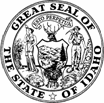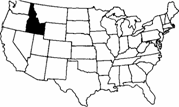State of Idaho
State of Idaho

capital city Boise, the largest city in the state, located on the Boise River in southwestern Idaho; population 125,738. Originally an army camp, it was founded as a settlement in 1863 and was incorporated as a city the following year, when it also became the territorial capital.
state name and nicknames The name "Idaho" is an artificial Indian word invented by George M. Willing. Also known as the Gem State and the Gem of the Mountains (the putative meaning of "Idaho").
state seal In the center is a shield showing a landscape, with the Snake River, mountains, a fir tree, and a farmer at the plow. Above the shield is an elk's head and the
state motto on a scroll; below it is a sheaf of wheat; to the right is a miner; to the left a woman holding symbols of justice and liberty. Along the bottom are agricultural symbols, including two cornucopias, the state flower, and ripened wheat. The yellow border reads "Great Seal of the State of Idaho."

The western state of Idaho belongs to the Mountain states. It is bordered on the north by Canada, on the east by Montana and Wyoming, on the south by Nevada and Utah, and on the west by Oregon, Washington, and the Snake River. It ranks 42nd in population and 14th in area among the states.
motto Esto Perpetua (It Is Forever)
song "Here We Have Idaho," lyrics by McKinley Helm and Albert J. Tompkins, music by Sallie Hume Douglas.
SYMBOLS
Flower syringa Tree white pine Bird mountain bluebird Gem star garnet Horse Appaloosa flag A blue field with the state seal in the center and below it a red band bearing the legend "State of Idaho."
As a Rocky Mountain state, Idaho is dominated by mountain terrain, with the Continental Divide forming Idaho's eastern border. The state contains some of the largest stretches of unspoiled wilderness in the continental U.S., with a wide diversity of flora and game. Idaho also boasts more than 2,000 lakes and ten major rivers. Heavily irrigated farmland lines the Snake River valley, the state's major drainage; Hell's Canyon, along the western Snake River, is the deepest gorge—about one mile in depth—in North America.
elevations Highest point-. Borah Peak, Cus-
ter County, 12,662 feet. Lowest point. Snake River, Nez Perce County, 710 feet. Mean elevation: 5,000 feet
major rivers Snake, Salmon, Clearwater
major lakes Pend Oreille, Coeur d'Alene, Priest, Bear, American Falls, Cascade, and Dworshak
temperatures (1990) The highest recorded temperature was 118°F on July 28, 1934, at Orotino. The lowest was —60°F on January 18, 1943, at Island Park Dam.
IDAHO IN HISTORY
1805 A U.S. expedition led by Meriwether Lewis and William Clark crosses what is now the Idaho panhandle en route to the Pacific coast.
1809 David Thompson of the North West Company establishes a trading post on the eastern shore of Lake Pend Oreille.
1810 Andrew Henry of the Missouri Fur Company establishes a camp on the fork of the Snake River but abandons it the following year.
1818 The United States and Great Britain agree on joint occupancy of the Pacific Northwest, including what is now Idaho.
1834 Fort Hall and Fort Boise are constructed to aid fur traders; these posts become stops on the Oregon Trail, which by 1845 is a well-traveled road.
1836 Henry Spalding establishes a mission to the Nez Perce Indians at Lapwai.
1846 June 15. A treaty with Great Britain establishes the Pacific Northwest below the 49th parallel as U.S. territory.
1848 August 14. Oregon Territory is created, including present-day Idaho.
1855 A treaty with the Koutenai, Pend Oreille, and Flathead Indians creates reservations for them in what is now Idaho and Montana. A treaty with the Nez Perce establishes for them a reserve in what is now Idaho, Oregon, and Washington.
I860 June 15. First permanent settlement in Idaho, at Franklin, by Mormons from Utah. In 1911 this day is proclaimed Pioneer Day.
1862 The Golden Age is Idaho's first newspaper and is published in Lewiston.
1863 March 4. Creation of Idaho Territory.
Some Nez Perce accept a smaller reservation replacing the 1855 area, overrun by gold prospectors. Chinese violence in 1866-1867 that leaves over a hundred dead. 1874 The Utah Northern Railroad reaches Franklin from Ogden, Utah.
1877 Nontreaty Nez Perce led by Chief Joseph, expelled from northeastern Oregon, are pursued through Idaho by federal troops before surrendering in Montana
1878 Forty whites and 78 Indians die in an uprising by Paiutes and Bannocks. Indian
warfare in Idaho ends the following year. 1880 Silver is found in the Wood River region. 1882 The Northern Pacific Railroad links northern Idaho to the east and the Pacific
Northwest seaports. .
1884 Completion of the Oregon Short Line Railroad from Wyoming through southern
Idaho to Oregon.
1885 Noah S. Kellogg finds silver in the Coeur d Alene area. 1 he Bunker Hill and Sullivan mines become the biggest in the chief lead-silver district in the U.S., which has yielded about $2 billion. . . Test Oath Act bars Mormons from voting, holding office, or serving on Juries These disabilities become part of the state constitution and remain in force until 1890 when Mormons renounce polygamy as an act of faith.
1892 Martial law is declared in northern Idaho mining towns, where the dispatch ot federal troops helps break a miners' strike. More than 600 union leaders and sympathizers are arrested.
1896-1902 Democrats, allied with Populists, control state politics. They also receive support from dissident Republicans who join in seeking the remonetization of silver.
1899 Dynamiting of Bunker Hill concentrator results in the reimposition of martial law and dispatch of U.S. troops. The Western Federation of Miners is suppressed, and hundreds of miners are imprisoned for six months.
1905 Women receive the right to vote.
December W. Former governor Frank Steunenberg is assassinated.
1907 Clarence Darrow successfully defends "Big Bill" Haywood and two other Western Federation of Miners officials found not guilty of conspiracy in Steunenberg s murder. William Borah, the prosecutor, is elected to the U.S. Senate; he servesuntil his death in 1940. . establishing the initiative, referendum and recall.
1912 Voters adopt constitutional amendments
1914 Moses Alexander is elected the first Jewish governor of any state.
1915 Arrowrock Dam, completed on the Boise River, is, at 354 feet, the highest dam in
the world. . 1922 Farmers are receiving less than one-third of 1919 prices for crops and livestock. 1927 The American Falls Dam, on the Snake River near Pocatello, provides irrigation
water for one million acres. Completion of U.S. Highway 95, the only land connection between northern and
southern Idaho.
1931 Adoption of a state income tax and a tax on private-power combines.
1932 As a result of the the Great Depression, average income has fallen 49 percent since 1929. Cash income of farmers has fallen by almost two-thirds.
1934 Idaho is first among states in silver and second in lead production. Shoshone County has the nation's largest silver mine (the Sunshine Mine) and the three largest lead producers. The state also ranks third in hay and fifth in wool.
1936 The Union Pacific Railroad creates Sun Valley as a ski resort.
1939 Per capita income has risen to $452 from $287 in 1933.
1942 Nearly 10,000 persons of Japanese ancestry are sent from the West Coast to an
internment camp at Hunt.
1951 The Atomic Energy Commission's National Reactor Testing Station, near Arco, successfully uses atomic energy to produce electricity. Opening, at Lewiston, of Idaho's first pulp and paper plant.